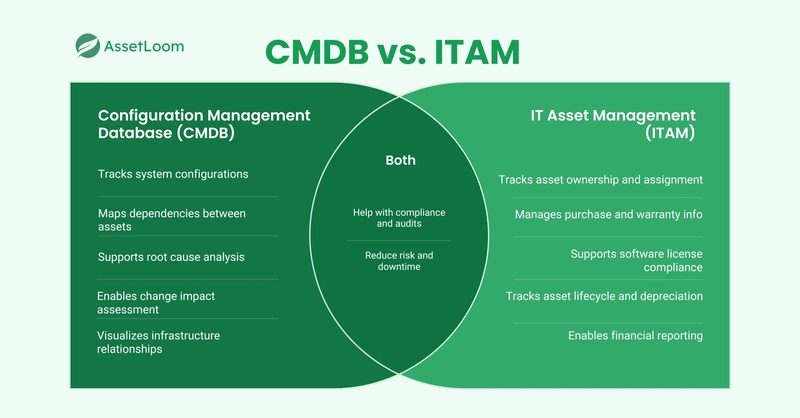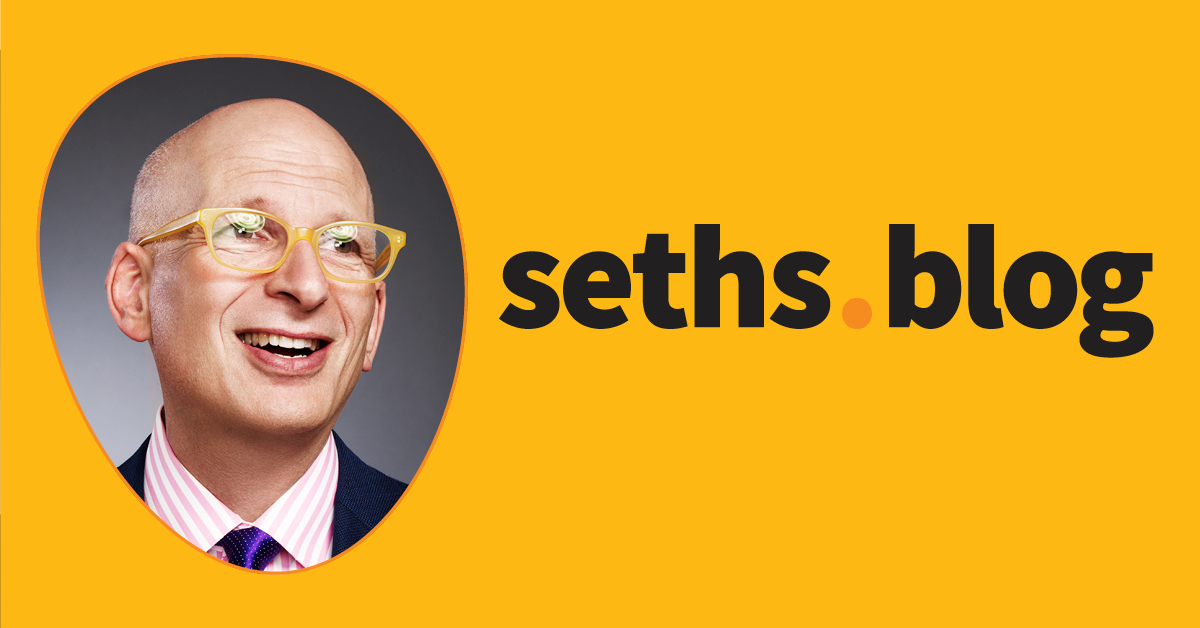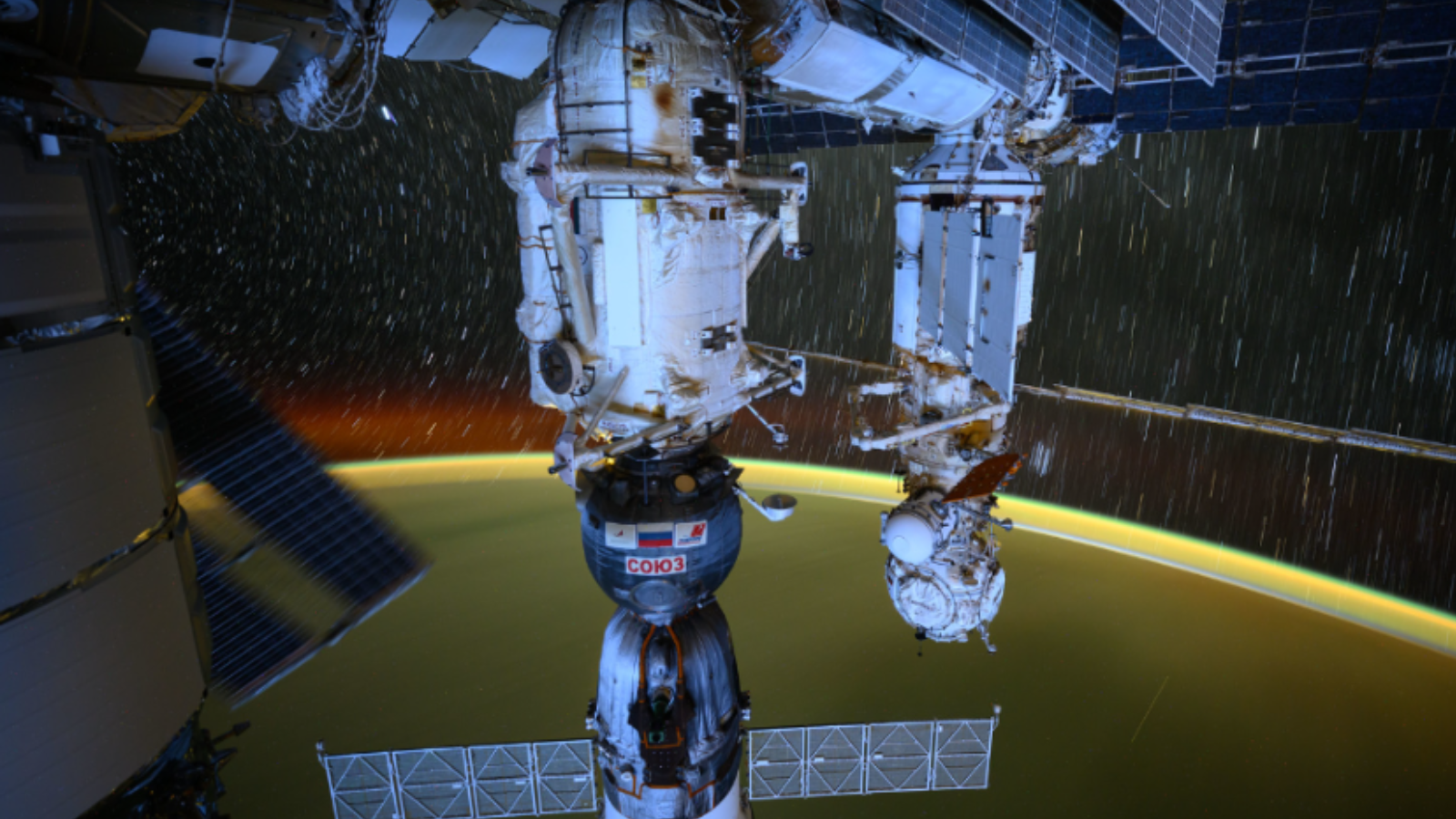CMDB vs IT Asset Management: What’s the Difference
Information Technology Asset Management (ITAM) and Configuration Management Databases (CMDB) are two terms that often show up together in IT conversations and they’re easy to mix up. After all, both deal with hardware, software, and the systems running inside a company. Both involve tracking and managing “IT assets.” But here’s the key difference: ITAM is about ownership, cost, and lifecycle of assets. CMDB is about how those assets work together in your IT environment. In this blog, we’ll walk through each concept, show you how they differ, and explain why understanding both matters, especially if your organization wants to reduce downtime, improve visibility, and manage IT smarter. What is IT Asset Management (ITAM)? IT Asset Management (ITAM) is the practice of tracking and managing all the technology assets your organization owns from laptops and monitors to software licenses, cloud subscriptions, and even printers. Basically, if it’s part of your company’s tech stack and has value, ITAM is responsible for knowing: What it is Who is using it Where it is How much it costs When it needs to be replaced ITAM helps businesses avoid unnecessary purchases, keep track of assets throughout their lifecycle, and ensure nothing goes missing or gets forgotten. What is a CMDB (Configuration Management Database)? A Configuration Management Database (CMDB) is a central place where your organization stores detailed information about its IT systems and how they’re connected. While ITAM focuses on ownership and cost, CMDB focuses on the technical side: What’s installed where How different systems interact What depends on what Think of it like a map of your IT environment , showing not just the devices, but how everything fits together behind the scenes. Key Differences between CMDB & IT Asset Management Core Focus: What Each One Is Really About While IT Asset Management (ITAM) and Configuration Management Database (CMDB) both deal with managing IT assets, their core focus is fundamentally different. They answer different questions, serve different goals, and are typically used by different teams. IT Asset Management (ITAM): Focus on Ownership, Cost, and Lifecycle ITAM is centered around the business side of assets. It helps organizations understand what they own, where it is, who is using it, how much it costs, and when it needs to be replaced or renewed. Primary goals: Track and optimize asset value Manage the full lifecycle (procurement to disposal) Ensure compliance with software licensing Prevent asset loss and overspending Example: Your company purchases 50 laptops for new employees. ITAM allows you to: Assign each device to a specific employee Track purchase date, warranty, and current status Monitor when the devices need to be replaced Ensure you're not paying for unused software licenses ITAM is especially valuable for procurement, finance, IT helpdesk, and compliance teams. Configuration Management Database (CMDB): Focus on Configuration, Relationships, and Impact CMDB, on the other hand, is focused on the technical configuration and relationships between systems. It gives IT teams a dynamic map of how different assets connect and interact within the infrastructure which is essential for diagnosing problems, planning changes, and preventing outages. Primary goals: Document the configuration of IT components (known as Configuration Itemse or CIs) Visualize relationships and dependencies between systems Enable faster incident response and root cause analysis Support change management and minimize business impact Example: An employee named Minh can't access the finance application. Using the CMDB, IT can: Identify that Minh’s laptop is running SAP Client See that it connects to Finance-Server-01 Discover that the finance server is currently down Quickly determine that the server outage is causing the issue CMDB is essential for IT operations, system administrators, DevOps teams, and security engineers. Different Use Cases Although ITAM and CMDB can work together, they are designed to solve different types of problems. Below is a breakdown of specific use cases and which system is best suited to handle them. Assigning a Laptop to a New Employee Use ITAM ITAM tracks which employee the asset is assigned to, its purchase date, warranty status, and license information. This is essential for onboarding and inventory accuracy. Troubleshooting a System Outage Use CMDB When a business-critical application goes down, CMDB helps IT teams identify which servers or systems are involved, how they’re connected, and which services are impacted. Renewing or Auditing Software Licenses Use ITAM ITAM can monitor software license usage across the organization to ensure compliance and avoid overpaying for unused seats. Performing Root Cause Analysis After an Incident Use CMDB A CMDB helps trace relationships between systems to find the exact point of failure —

Information Technology Asset Management (ITAM) and Configuration Management Databases (CMDB) are two terms that often show up together in IT conversations and they’re easy to mix up.
After all, both deal with hardware, software, and the systems running inside a company. Both involve tracking and managing “IT assets.” But here’s the key difference:
ITAM is about ownership, cost, and lifecycle of assets. CMDB is about how those assets work together in your IT environment.
In this blog, we’ll walk through each concept, show you how they differ, and explain why understanding both matters, especially if your organization wants to reduce downtime, improve visibility, and manage IT smarter.
What is IT Asset Management (ITAM)?
IT Asset Management (ITAM) is the practice of tracking and managing all the technology assets your organization owns from laptops and monitors to software licenses, cloud subscriptions, and even printers.
Basically, if it’s part of your company’s tech stack and has value, ITAM is responsible for knowing:
- What it is
- Who is using it
- Where it is
- How much it costs
- When it needs to be replaced
ITAM helps businesses avoid unnecessary purchases, keep track of assets throughout their lifecycle, and ensure nothing goes missing or gets forgotten.
What is a CMDB (Configuration Management Database)?
A Configuration Management Database (CMDB) is a central place where your organization stores detailed information about its IT systems and how they’re connected.
While ITAM focuses on ownership and cost, CMDB focuses on the technical side:
- What’s installed where
- How different systems interact
- What depends on what
Think of it like a map of your IT environment , showing not just the devices, but how everything fits together behind the scenes.
Key Differences between CMDB & IT Asset Management
Core Focus: What Each One Is Really About
While IT Asset Management (ITAM) and Configuration Management Database (CMDB) both deal with managing IT assets, their core focus is fundamentally different.
They answer different questions, serve different goals, and are typically used by different teams.
IT Asset Management (ITAM): Focus on Ownership, Cost, and Lifecycle
ITAM is centered around the business side of assets.
It helps organizations understand what they own, where it is, who is using it, how much it costs, and when it needs to be replaced or renewed.
Primary goals:
Track and optimize asset value
Manage the full lifecycle (procurement to disposal)
Ensure compliance with software licensing
Prevent asset loss and overspending
Example: Your company purchases 50 laptops for new employees. ITAM allows you to:
Assign each device to a specific employee
Track purchase date, warranty, and current status
Monitor when the devices need to be replaced
Ensure you're not paying for unused software licenses
ITAM is especially valuable for procurement, finance, IT helpdesk, and compliance teams.
Configuration Management Database (CMDB): Focus on Configuration, Relationships, and Impact
CMDB, on the other hand, is focused on the technical configuration and relationships between systems.
It gives IT teams a dynamic map of how different assets connect and interact within the infrastructure which is essential for diagnosing problems, planning changes, and preventing outages.
Primary goals:
Document the configuration of IT components (known as Configuration Itemse or CIs)
Visualize relationships and dependencies between systems
Enable faster incident response and root cause analysis
Support change management and minimize business impact
Example: An employee named Minh can't access the finance application. Using the CMDB, IT can:
Identify that Minh’s laptop is running SAP Client
See that it connects to Finance-Server-01
Discover that the finance server is currently down
Quickly determine that the server outage is causing the issue
CMDB is essential for IT operations, system administrators, DevOps teams, and security engineers.
Different Use Cases
Although ITAM and CMDB can work together, they are designed to solve different types of problems. Below is a breakdown of specific use cases and which system is best suited to handle them.
Assigning a Laptop to a New Employee
Use ITAM ITAM tracks which employee the asset is assigned to, its purchase date, warranty status, and license information. This is essential for onboarding and inventory accuracy.Troubleshooting a System Outage
Use CMDB When a business-critical application goes down, CMDB helps IT teams identify which servers or systems are involved, how they’re connected, and which services are impacted.Renewing or Auditing Software Licenses
Use ITAM ITAM can monitor software license usage across the organization to ensure compliance and avoid overpaying for unused seats.Performing Root Cause Analysis After an Incident
Use CMDB A CMDB helps trace relationships between systems to find the exact point of failure — whether it’s a server, network configuration, or a dependency that went down.Managing the Lifecycle of Devices
Use ITAM ITAM enables businesses to track the full lifecycle of assets — from procurement to retirement — and budget accordingly for replacements or upgrades.Understanding What Systems Are Affected by a Change
Use CMDB Before making a change (e.g., updating a server), a CMDB can show you all the systems that depend on it — so you can assess the risk and avoid unintended downtime.Tracking Asset Depreciation for Financial Reporting
Use ITAM ITAM tracks asset costs, depreciation schedules, and useful life for accounting and reporting purposes.Mapping the Infrastructure for Security Audits or Compliance
Use CMDB (and sometimes both) A CMDB helps visualize system architecture and dependencies, which is useful for understanding data flows, enforcing controls, and responding to audits.
Why You Need Both (Not One or the Other)
While IT Asset Management (ITAM) and Configuration Management Databases (CMDB) serve distinct purposes, they become significantly more valuable when used together. ITAM provides visibility into the business aspects of your assets — such as ownership, cost, and lifecycle — while CMDB offers a technical view, showing how those assets are configured and how they interact within your infrastructure. Individually, each gives you a partial perspective; together, they provide a comprehensive understanding of your IT environment.
Using only ITAM can leave you blind to critical technical relationships. You may know who owns a device, when it was purchased, and whether it's still under warranty, but you won't be able to see how it connects to other systems or what the ripple effects might be if it fails. On the flip side, relying only on a CMDB gives you technical depth but no business context — you might know a server is part of a mission-critical workflow, but not that it’s out of warranty, running unlicensed software, or scheduled for decommissioning.
By combining both systems, your organization can make smarter, faster decisions. If an application goes down, the CMDB helps you trace the issue across dependent systems, while ITAM can tell you if the affected asset is due for replacement or under support coverage. This synergy enables more efficient troubleshooting, informed planning, and better governance. Ultimately, using ITAM and CMDB together allows both technical and business teams to align around a shared, accurate view of your IT ecosystem.
If you're looking for a modern, integrated way to manage both your IT assets and your configuration data, AssetLoom is built for that. AssetLoom combines the power of IT Asset Management (ITAM) and CMDB in one unified platform — giving your organization full visibility into both the business and technical layers of your IT environment.
Conclusion
Understanding the difference between IT Asset Management and a Configuration Management Database is more than a technical distinction — it’s a strategic one. ITAM helps you manage the value, cost, and usage of your assets. CMDB helps you manage the complexity, relationships, and behavior of your systems. When used separately, each tool has limits. But when used together, they give you a complete picture of your IT environment — enabling better decisions, faster responses, and stronger alignment between technical and business goals.
With a platform like AssetLoom, you don’t have to choose one or the other. You get the best of both worlds in a single, streamlined solution. So whether you're scaling up your infrastructure or tightening up control, AssetLoom is here to support the entire lifecycle and configuration of your IT assets — intelligently and efficiently.








![[FREE EBOOKS] Machine Learning Hero, AI-Assisted Programming for Web and Machine Learning & Four More Best Selling Titles](https://www.javacodegeeks.com/wp-content/uploads/2012/12/jcg-logo.jpg)



















.jpg)











































